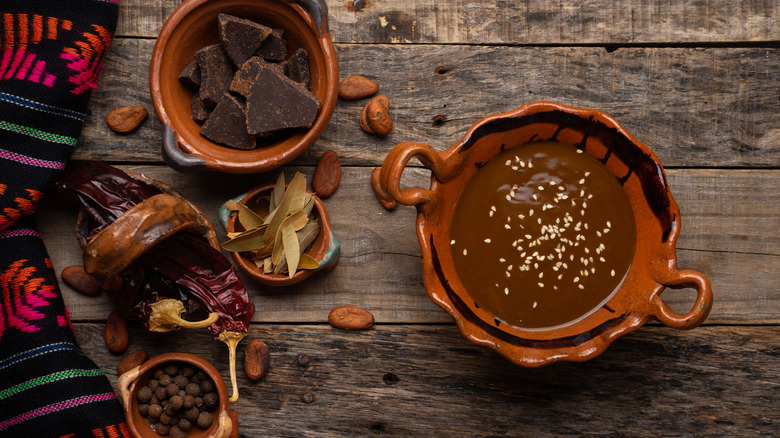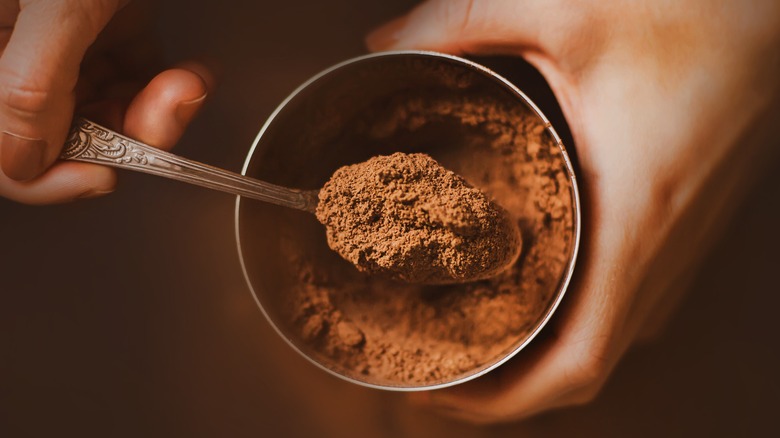Cocoa Powder Is The Secret Ingredient To Upgrade Canned Chili
Chili is cozy and comforting and beloved by (almost) all — but it's also a long-simmering dish that often demands a lot of active browning, chopping, sweating, and stirring. We all know that canned chili isn't as good as the homemade stuff, but when you need dinner and don't want to spend hours over the stove, it sure is handy. But what if it could be better? What if you could upgrade your canned chili in just a few minutes ... with chocolate?
This isn't just because chocolate makes practically everything better (even though that's true, too). This upgrade, which actually uses unsweetened cocoa powder, is a favorite of a few chefs for its ability to add complexity to chili. This includes Martha Stewart, who adds cocoa to her chili, too.
The hack doesn't take much, as just a dash will begin to make a difference. How much you add will depend on how sensitive you are to bitter flavors. That's because cocoa powder, even when it's been cooked, will impart a bitter note to the final dish. Adding too much will overpower the chili, but just enough is a revelation that creates wonderful complexity. This echoes cocoa-rich mole sauce, used in Mesoamerican and Mexican cooking alongside tomatoes and chilies for a long, long time.
Why cocoa powder works in chili
Although cocoa might be a weird addition to caprese salad or jalapeño poppers, it works well with stewed tomatoes and roasted chilies because of shared flavor molecules. Tomatoes and chilies are both part of the nightshade family. Meanwhile, chocolate is a member of the Malvaceae family, making it more closely related to okra and hibiscus. But all three share important aromatic compounds that help them work together. Cocoa alone contains over 600 flavor compounds — at least some of them have to line up.
Some of the main aroma compounds in tomatoes are 3-methylbutanal and 3-methyl-1-butanol, both of which feature cocoa notes, trans-linalool-oxide (shared with cocoa), and 4-methylpentanoic acid, which is shared with peppers. One of the main aroma compounds of cocoa is 3-methyltutanoic acid, closely related to the compounds in tomatoes that smell like cocoa. Shared flavinoid and aromatic compounds can help explain why tomatoes and strawberries shine together in a spinach salad, why strawberries and chocolate pair so well, and why black pepper works will all three.
Ways to add cocoa powder to chili
If you have the time, cocoa does best when bloomed. Unlike many spices, which require fat to diffuse their flavors, cocoa can be bloomed with hot liquid. Add it to melted butter or heat it with a splash of water or broth, then cook the cocoa for a minute before adding your can of chili to the pot. If there's enough liquid in the chili itself, add the cocoa straight into the chili. Just make sure to cook the chili for a few extra minutes to fully incorporate the cocoa flavor.
The type of cocoa you use — natural or Dutch-processed — can make a big difference. Natural process cocoa is a bit more intense and acidic and can add an extra pop to your chili. Or, if your chili is already quite acidic, it can throw off the balance of flavor. Dutch-processed cocoa has been alkalized, making the pH more neutral and mellowing out the flavor. Black cocoa is ultra-alkalized and will create a similar flavor profile as Dutch-processed, but more intense. It will also likely darken your chili. Whatever cocoa powder you choose, always add a little at a time and taste until it's just right.


